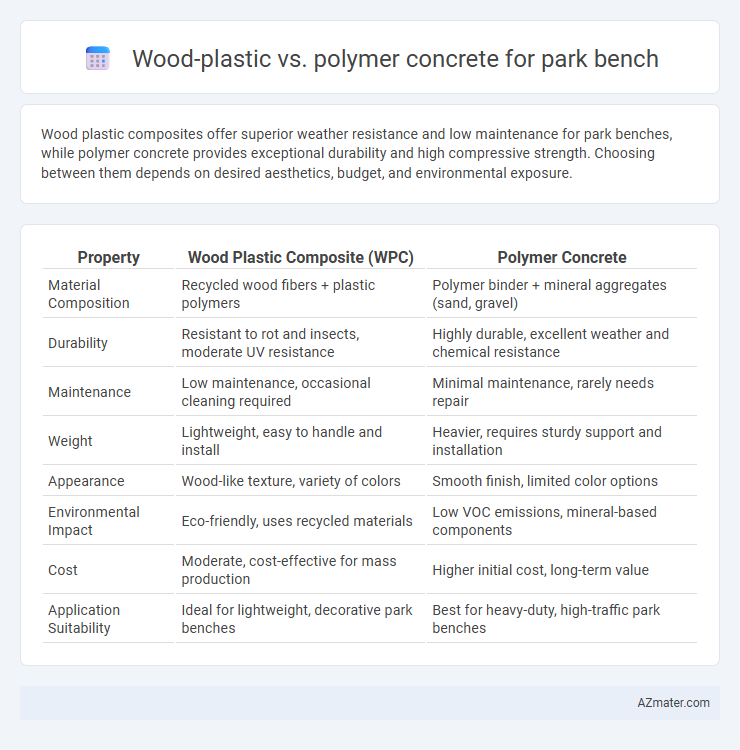Wood plastic composites offer superior weather resistance and low maintenance for park benches, while polymer concrete provides exceptional durability and high compressive strength. Choosing between them depends on desired aesthetics, budget, and environmental exposure.
Table of Comparison
| Property | Wood Plastic Composite (WPC) | Polymer Concrete |
|---|---|---|
| Material Composition | Recycled wood fibers + plastic polymers | Polymer binder + mineral aggregates (sand, gravel) |
| Durability | Resistant to rot and insects, moderate UV resistance | Highly durable, excellent weather and chemical resistance |
| Maintenance | Low maintenance, occasional cleaning required | Minimal maintenance, rarely needs repair |
| Weight | Lightweight, easy to handle and install | Heavier, requires sturdy support and installation |
| Appearance | Wood-like texture, variety of colors | Smooth finish, limited color options |
| Environmental Impact | Eco-friendly, uses recycled materials | Low VOC emissions, mineral-based components |
| Cost | Moderate, cost-effective for mass production | Higher initial cost, long-term value |
| Application Suitability | Ideal for lightweight, decorative park benches | Best for heavy-duty, high-traffic park benches |
Introduction to Park Bench Material Options
Wood plastic composites offer durability, weather resistance, and eco-friendliness by combining recycled plastics with wood fibers, making them suitable for park benches exposed to outdoor elements. Polymer concrete boasts high compressive strength, chemical resistance, and minimal maintenance due to its composite of polymer resin and inorganic aggregates, ideal for robust park bench structures. Both materials provide sustainable and long-lasting alternatives to traditional wood or metal, with specific benefits tailored to varying environmental and design requirements in public park settings.
Overview of Wood Plastic Composites
Wood Plastic Composites (WPC) are engineered materials combining wood fibers and thermoplastics, offering enhanced durability and resistance to moisture compared to traditional wood. Their recyclable nature and low maintenance requirements make them ideal for park bench construction, providing long-lasting performance in outdoor environments. WPCs also exhibit superior resistance to rot, termites, and UV degradation, ensuring effective longevity in public spaces.
What is Polymer Concrete?
Polymer concrete is a composite material consisting of a mixture of polymer resins and inorganic aggregates, offering superior strength and durability compared to traditional concrete. Unlike wood plastic composites, polymer concrete provides enhanced resistance to weathering, chemical exposure, and mechanical stress, making it ideal for outdoor applications like park benches. Its ability to be molded into various shapes with high load-bearing capacity ensures long-lasting, low-maintenance seating solutions in public spaces.
Durability Comparison: Wood Plastic vs Polymer Concrete
Wood plastic composites (WPC) offer moderate durability with resistance to rot, insects, and moisture but may degrade under prolonged UV exposure and heavy mechanical stress. Polymer concrete exhibits superior durability, featuring exceptional resistance to weathering, chemical corrosion, and high compressive strength, making it ideal for heavy-use park benches. Long-term maintenance costs tend to be lower for polymer concrete due to its enhanced structural integrity and minimal susceptibility to environmental damage compared to WPC.
Maintenance Requirements and Longevity
Wood plastic composites used for park benches require minimal maintenance, resisting rot, insects, and moisture better than traditional wood, ensuring a long lifespan typically exceeding 15 years. Polymer concrete benches offer exceptional durability with high resistance to weathering, abrasion, and vandalism, often lasting over 25 years with almost no maintenance. The choice between wood plastic and polymer concrete depends on desired longevity and upkeep, with polymer concrete providing superior long-term performance but higher initial costs.
Environmental Impact and Sustainability
Wood plastic composites (WPC) offer significant environmental benefits for park benches due to their use of recycled wood fibers and plastic, reducing landfill waste and promoting material reuse. Polymer concrete, although durable and resistant to weathering, primarily relies on synthetic resins and aggregates, which can involve higher carbon emissions during production and limited recyclability. WPC's ability to be fully recycled and its reduced reliance on virgin materials position it as a more sustainable choice for eco-conscious outdoor furnishing.
Cost Analysis: Initial and Long-term Expenses
Wood plastic composites typically have lower initial costs compared to polymer concrete, making them an attractive option for budget-conscious park bench projects. Polymer concrete offers superior durability and resistance to weathering and vandalism, which translates to lower long-term maintenance and replacement expenses. Investing in polymer concrete often results in better cost-efficiency over the bench's lifespan, despite the higher upfront price.
Aesthetic and Design Flexibility
Wood plastic composites offer a natural wood-like texture and color variations that enhance aesthetic appeal, making park benches visually warm and inviting. Polymer concrete provides superior design flexibility, allowing for intricate shapes, smooth finishes, and custom color options that suit modern and innovative park environments. Both materials support diverse design needs, but polymer concrete excels in achieving complex forms and high durability for long-lasting aesthetic integrity.
Safety and Comfort Considerations
Wood plastic composites for park benches offer enhanced safety through resistance to splintering and reduced risk of sharp edges, while providing comfort with a smoother surface and slight flexibility under weight. Polymer concrete benches excel in safety by being fire-resistant, vandal-proof, and non-toxic, yet their rigid, hard surface may reduce seating comfort over extended periods. Both materials balance durability and user protection, but wood plastic composites typically deliver greater ergonomic comfort for park visitors.
Conclusion: Choosing the Best Material for Park Benches
Wood plastic composites offer durability and low maintenance with resistance to weather and rot, making them ideal for park benches in varied climates. Polymer concrete provides superior strength, heavy-load resistance, and vandal-proof qualities, suitable for high-traffic urban parks. Selecting the best material depends on specific park conditions, budget constraints, and desired longevity, with wood plastic favored for aesthetic appeal and polymer concrete preferred for robustness.

Infographic: Wood plastic vs Polymer concrete for Park Bench
 azmater.com
azmater.com